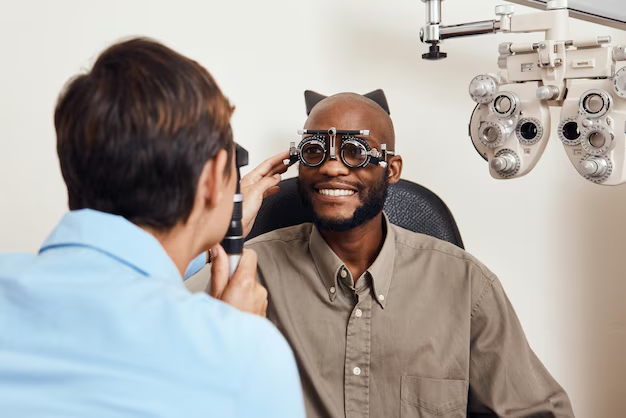Can Cataracts Cause Eye Floaters? Understanding the Connection
Seeing specks floating across your vision can be unsettling. Many people wonder, "Can cataracts cause this?" Eye health often brings more questions than answers, and understanding whether cataracts and floaters are linked is crucial for those seeking clarity on their visual symptoms.
What Are Cataracts?
Cataracts are a common eye condition characterized by the clouding of the natural lens in the eye. This clouding can cause vision to become blurry, dim, or less colorful, significantly affecting daily life. Typically associated with aging, cataracts can develop slowly and may not immediately impact vision. However, over time, they can lead to significant visual impairment if untreated.
Key Characteristics of Cataracts:
- Gradual progression: Symptoms develop slowly.
- Vision symptoms: Blurriness, sensitivity to light, and difficulty seeing at night.
- Common with aging: Primarily affects people over 60.
What Are Eye Floaters?
Eye floaters are tiny spots or shapes that appear to drift through your field of vision. They can look like black or gray specks, strings, or cobweb-like intrusions. These floaters are small clumps within the vitreous, the gel-like substance that fills the eye.
Common Causes of Floaters:
- Aging: The vitreous gel shrinks over time, leading to clumps.
- Eye Surgery or Injury: Disturbances in the vitreous can introduce floaters.
- Retinal Tears or Detachments: Sudden increase in floaters might point to more severe issues.
Are Cataracts and Floaters Connected?
While both cataracts and floaters are part of age-related eye changes, they arise from different causes and do not directly influence each other's development. Cataracts affect the lens of the eye, while floaters are disturbances in the vitreous. Even though both conditions can coexist, neither directly causes the other.
The Myth of Connection:
- Coexistence is not causation: Presence of both cataracts and floaters in an older individual is common but unrelated in terms of direct cause and effect.
What Might Lead to Belief in a Link:
- Simultaneous Symptoms: Age-related changes can cause both conditions to manifest around the same time, leading to misconceptions.
How Are Cataracts and Floaters Diagnosed?
Diagnosis of Cataracts:
- Eye Examination: A comprehensive eye exam by an ophthalmologist.
- Visual Acuity Test: Measures how well you see at various distances.
- Slit-lamp Examination: Allows the doctor to see structures at the front of the eye.
- Retinal Exam: The doctor examines the back of your eye after dilation.
Diagnosis of Floaters:
- Dilated Eye Exam: Enables the doctor to look at the vitreous and retina for signs of clumps or tears.
- Ultrasound: Can be used if retinal detachment is suspected.
Treatment Options
Cataract Treatment:
- Surgery: The most effective treatment is the surgical removal of the clouded lens, replaced with an artificial lens.
Managing Floaters:
- Observation: Often, floaters do not require treatment and may become less noticeable over time.
- Vitrectomy: In severe cases, removal of the vitreous can dramatically reduce floaters, though it's a procedure generally reserved for significant visual disruption.
Living with Cataracts and Floaters
For those dealing with cataracts or floaters, understanding and managing symptoms can improve quality of life.
Cataracts Management Tips:
- Regular Eye Checkups: Monitor progression and receive timely advice.
- Good Lighting: Improve vision when dealing with cataracts.
- Corrective Lenses: Adjust vision for improvement until surgery is considered.
Coping with Floaters:
- Eye Movement: Moving the eyes up and down can shift floaters out of central vision.
- Reducing Stress: Keeping calm if floaters appear suddenly, but seeking medical advice if there's a sudden increase.
When to Seek Help
For Cataracts:
- Noticeable Vision Impact: If daily activities are affected, surgical evaluation may be advisable.
For Floaters:
- Sudden Increase: A surge in floaters or flashes of light should prompt an immediate visit to the eye doctor.
Understanding Your Options: Decision-Making
Deciding on the best course of action for cataracts or floaters involves understanding the implications of each condition.
Considerations for i-Cataract Surgery:
- Weigh life-impact changes vs. surgical risks and benefits.
- Discuss options with your ophthalmologist to understand the potential outcomes.
Monitoring Floaters:
- Regular check-ups to observe any changes in vision alongside floaters.
Quick Reference Summary 📝
The information below summarizes essential insights and proactive steps for dealing with cataracts and eye floaters.
- Cataracts: Develop slowly with age, causing vision to become cloudy.
- Floaters: Visual specks that move with your eyes, related to vitreous changes.
- Connection: Both conditions are age-related but have different causes. They can occur simultaneously but are not causally linked.
- Diagnosis: Consult an eye professional for comprehensive evaluation if you suspect either condition.
- Treatment: Cataracts may require surgery, while floaters often need no treatment unless they pose significant disruption.
- When to Act: Seek immediate attention for sudden increase in floaters or significant vision changes.
Understanding the complexity of eye conditions like cataracts and floaters is crucial for proactive eye health. Staying informed and consulting with eye care professionals can lead to better outcomes and quality of life as we navigate the changes that come with age.
